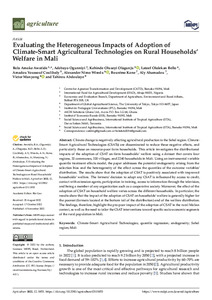| dc.contributor.author | Awotide, B.A. |
| dc.contributor.author | Ogunniyi, A. |
| dc.contributor.author | Olagunju, K.O. |
| dc.contributor.author | Bello, L.O. |
| dc.contributor.author | Coulibaly, A.Y. |
| dc.contributor.author | Wiredu, A.N. |
| dc.contributor.author | Kone, B. |
| dc.contributor.author | Ahamadou, A. |
| dc.contributor.author | Manyong, V. |
| dc.contributor.author | Abdoulaye, T. |
| dc.date.accessioned | 2022-11-28T11:39:07Z |
| dc.date.available | 2022-11-28T11:39:07Z |
| dc.date.issued | 2022-11-04 |
| dc.identifier.citation | Awotide, B.A., Ogunniyi, A., Olagunju, K.O., Bello, L.O., Coulibaly, A.Y., Wiredu, A.N., ... & Abdoulaye, T. (2022). Evaluating the heterogeneous impacts of adoption of climate-smart agricultural technologies on rural households' welfare in Mali. Agriculture, 12(11), 1-16. |
| dc.identifier.issn | 2077-0472 |
| dc.identifier.uri | https://hdl.handle.net/20.500.12478/7935 |
| dc.description.abstract | Climate change is negatively affecting agricultural production in the Sahel region. Climate-Smart Agricultural Technologies (CSATs) are disseminated to reduce these negative effects, and particularly those on resource-poor farm households. This article investigates the distributional impacts of the adoption of CSAT on-farm households’ welfare using a dataset that covers four regions, 32 communes, 320 villages, and 2240 households in Mali. Using an instrumental variable quantile treatment effects model, the paper addresses the potential endogeneity arising from the selection bias and the heterogeneity of the effect across the quantiles of the outcome variables’ distribution. The results show that the adoption of CSAT is positively associated with improved households’ welfare. The farmers’ decision to adopt any CSAT is influenced by access to credit, contact with extension agents, participation in training, access to information through the television, and being a member of any organization such as a cooperative society. Moreover, the effect of the adoption of CSAT on household welfare varies across the different households. In particular, the results show that the impact of the adoption of CSAT on households’ welfare is generally higher for the poorest (farmers located at the bottom tail of the distribution) end of the welfare distribution. The findings, therefore, highlight the pro-poor impact of the adoption of CSAT in the rural Malian context, as well as the need to tailor the CSAT interventions toward specific socio-economic segments of the rural population in Mali. |
| dc.description.sponsorship | Royal Norwegian Embassy in Mali |
| dc.format.extent | 1-16 |
| dc.language.iso | en |
| dc.subject | Climate Smart Agriculture |
| dc.subject | Climate Change |
| dc.subject | Rural Communities |
| dc.subject | Mali |
| dc.subject | Households |
| dc.subject | Welfare |
| dc.title | Evaluating the heterogeneous impacts of adoption of climate-smart agricultural technologies on rural households' welfare in Mali |
| dc.type | Journal Article |
| cg.contributor.crp | Maize |
| cg.contributor.crp | Roots, Tubers and Bananas |
| cg.contributor.crp | Policies, Institutions and Markets |
| cg.contributor.affiliation | Centre for Agrarian Transformation and Development, Mali |
| cg.contributor.affiliation | International Fund for Agricultural Development |
| cg.contributor.affiliation | Department of Agriculture, Environment and Rural Affairs, UK |
| cg.contributor.affiliation | University of Tokyo |
| cg.contributor.affiliation | Institut de Pedagogie Universitaire, Mali |
| cg.contributor.affiliation | AKDE Solutions Ghana Ltd. |
| cg.contributor.affiliation | Institut d’Economie Rurale, Mali |
| cg.contributor.affiliation | International Institute of Tropical Agriculture |
| cg.coverage.region | Africa |
| cg.coverage.region | West Africa |
| cg.coverage.country | Mali |
| cg.coverage.hub | Eastern Africa Hub |
| cg.coverage.hub | Headquarters and Western Africa Hub |
| cg.researchtheme | Social Science and Agribusiness |
| cg.identifier.bibtexciteid | AWOTIDE:2022 |
| cg.isijournal | ISI Journal |
| cg.authorship.types | CGIAR and developing country institute |
| cg.iitasubject | Agribusiness |
| cg.iitasubject | Agronomy |
| cg.iitasubject | Climate Change |
| cg.iitasubject | Food Security |
| cg.iitasubject | Livelihoods |
| cg.iitasubject | Post-Harvesting Technology |
| cg.iitasubject | Socioeconomy |
| cg.journal | Agriculture |
| cg.notes | Open Access Journal; Published online: 04 Nov 2022 |
| cg.accessibilitystatus | Open Access |
| cg.reviewstatus | Peer Review |
| cg.usagerightslicense | Creative Commons Attribution 4.0 (CC BY 0.0) |
| cg.targetaudience | Scientists |
| cg.identifier.doi | https://dx.doi.org/10.3390/agriculture12111853 |
| cg.iitaauthor.identifier | Victor Manyong: 0000-0003-2477-7132 |
| cg.iitaauthor.identifier | Tahirou Abdoulaye: 0000-0002-8072-1363 |
| cg.futureupdate.required | No |
| cg.identifier.issue | 11 |
| cg.identifier.volume | 12 |

